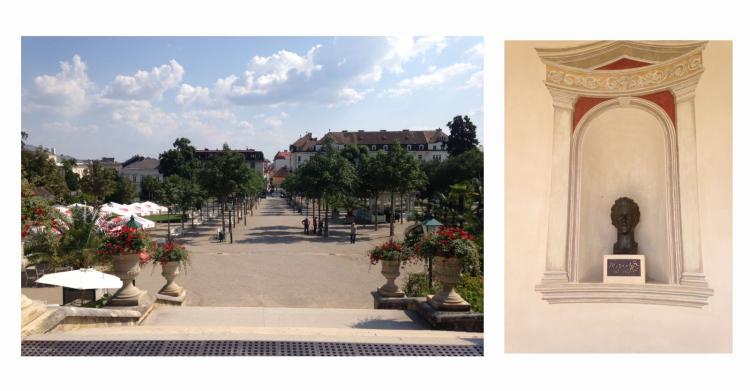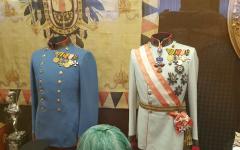Baden – A town of gambling, royal mistresses, and fountains inspired by water nymphs
Visiting Vienna is, of course, always worthwhile. One gets to visit royal palaces, such as the famous Hofburg, Schönbrunn, the Belvedere… not to mention the various museums and art galleries where the glorious House of Habsburg is one of, if not the, focal point. Yet sometimes, the touristy rush of Austria’s capital becomes overwhelming, and one yearns to just escape it all for a while. Still, a daily Habsburg fix is vital when on holiday, at least for me. The solution is simple: Why not travel just a few kilometres (26, to be precise) south of Vienna, to the spa town of Baden?
The Floral Clock

I mainly associate Baden with the actress Katharina Schratt, friend and perhaps “mistress” of Emperor Franz Joseph. She was born in Baden in 1853, and, to my delight, her place of birth is still commemorated by a plate saying Schratt-Haus. It now, ironically, houses a dessous shop and an Italian restaurant. Given the fact that Katharina Schratt, a curvaceous beauty, certainly had many male admirers and also appreciated fine food, it seems rather apt.
Schratt-Haus

At the age of 17, Katharina performed on stage at the Municipal Theatre of Baden. The building I admired during my stay in Baden, was, however, a different one, since it was completely rebuilt in 1908. Against the backdrop of a blue summer sky, surrounded by palm trees, it looked utterly magical.
The Theatre

Reminders of historical figures can be spotted everywhere in Baden! For instance, the house where Beethoven once stayed while in town is a popular sightseeing spot. Whilst strolling through the spa gardens (Kurpark), I got to see a bust of the popular Austrian poet Franz Grillparzer, another one of Maria Theresia’s protégé, Mozart, as well as a statue of the Austrian Romantic composers Johann Strauss I. and Joseph Lanner. These two are actually responsible for making the waltz, which used to be a simple peasant dance, popular amongst the aristocracy.
Photo 1: The Lanner and Strauss Statue. Photo 2: The Casino. Photo 3: The view of the gardens from a bench. Photo 4: Mozart.


The Kurpark also features a very special floral clock, which some may find kitschy – I considered it to be rather adorable! Baden’s casino, which is located within the grounds of the Kurpark, exudes a majestic vibe. Built in the 1880s in the Renaissance Revival style, its yellow façade is typical of the k.&k. (kaiserlich & königlich, which means as much as Imperial and Royal) era. I don’t know about you, but these kinds of buildings always look so delectable, they actually remind me of cake and pastry…
Make sure to plan in some time for just resting on one of the Kurpark’s many benches, and enjoying the view. I promise you that just being surrounded by all these sumptuous flowers and balmy fragrances will make you feel quite at peace with life!
Before you exit the park, however, don’t miss the Undine fountain. It was created by Josef Valentin Kassin in honour of the completion of Baden’s water supply system. While this sounds all very technical, the actual inspiration behind the fountain is a literary one: In 1811, the German Romantic writer Friedrich de la Motte Fouqué published the story of a water nymph called Undine, who fell desperately in love with a knight called Huldebrand. While he did reciprocate her feelings at first, he eventually felt more drawn to his former fiancé, the rather arrogant Bertalda. Undine got her revenge by literally kissing Huldebrand him to death… (If you haven’t read the novella, I strongly encourage you to do so!). The fountain is spectacular and quite dramatic in its depiction of the Undine myth.
Undine Fountain

In the mood to do some reading now? Baden boasts several charming old-fashioned bookstores, where you can acquire (sometimes antiquarian) literature on the Habsburgs you wouldn’t find anywhere else.
How to get to Baden from Vienna: Take the Badener Bahn from Vienna’s Oper tram station.
Grillparzer




